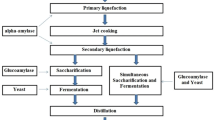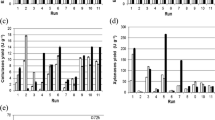Abstract
Studies on simultaneous saccharification and fermentation (SSF) of wheat bran flour, a grain milling residue as the substrate using coculture method were carried out with strains of starch digesting Aspergillus niger and nonstarch digesting and sugar fermenting Kluyveromyces marxianus in batch fermentation. Experiments based on central composite design (CCD) were conducted to maximize the glucose yield and to study the effects of substrate concentration, pH, temperature, and enzyme concentration on percentage conversion of wheat bran flour starch to glucose by treatment with fungal α-amylase and the above parameters were optimized using response surface methodology (RSM). The optimum values of substrate concentration, pH, temperature, and enzyme concentration were found to be 200 g/L, 5.5, 65°C and 7.5 IU, respectively, in the starch saccharification step. The effects of pH, temperature and substrate concentration on ethanol concentration, biomass and reducing sugar concentration were also investigated. The optimum temperature and pH were found to be 30°C and 5.5, respectively. The wheat bran flour solution equivalent to 6% (w/V) initial starch concentration gave the highest ethanol concentration of 23.1 g/L after 48 h of fermentation at optimum conditions of pH and temperature. The growth kinetics was modeled using Monod model and Logistic model and product formation kinetics using Leudeking-Piret model. Simultaneous saccharificiation and fermentation of liquefied wheat bran starch to bioethanol was studied using coculture of amylolytic fungus A. niger and nonamylolytic sugar fermenting K. marxianus.
Similar content being viewed by others
References
Roble N D, Ogbonna J C, Tanaka H. A novel circulating loop bioreactor with cell immobilized in loofa (Luffa cylindrical) sponge for the bioconversion of raw cassava starch to ethanol. Appl Microbiol Biotechnol, 2002, 60: 671–678
Sree N K, Sridhar M, Suresh K, Banat I M, Rao L V. High alcohol production by repeated batch fermentation using an immobilized osmotolerant Saccharomyces cerevesiae. J Ind Microbiol, 2000, 24: 222–226
Neves M A D, Kimura T, Shimizu N. Production of alcohol by simultaneous saccharification and fermentation of low grade wheat flour. Brazilian Arch Biol Technol, 2006, 49: 481–190
Lee J H, Pagan R J, Rogers P L. Continuous simultaneous saccharification and fermentation of starch using Zymmomonas mobilis. Biotechnol Bioeng, 1983, 25: 659–669
Tanaka H, Kurosawa H, Murakama H. Ethanol production from starch by a co-immobilized mixed culture system of Aspergillus awamori and Zymmomonas mobilis. Biotechnol Bioeng, 1986, 28: 1761–1768
Verma G, Nigam P, Singh D, Chaudhary K. Bioconversion of starch to ethanol in a single step process by coculture of amylolytic yeasts and Saccharomyces cerevisiae. Bioresour Technol, 2000, 72: 261–266
Nigam P, Singh D. Enzyme and microbial systems involved in starch processing. Enzy Microbial Technol, 1995, 17: 770–778
Nakamura Y, Kobayashi F, Ohnaga M, Swada T. Alcohol fermentation of starch by genetic recombinant yeast having glucoamylase activity. Biotechnol Bioeng, 1997, 53: 21–25
Ratnam B V V, Narasimha Rao M, Damodara Rao M, Subba Rao S, Ayyanna C. Optimization of fermentation conditions for production of ethanol from sago starch using response surface methodology. J Microbiol Biotechnol, 2003, 19: 523–526
Ratnam Bandaru V V, Subba Rao S, Raomendu D, Narasima Rao M, Chityala A. Optimization of fermentation condition for the production of ethanol from sago starch by co-immobilized amyloglucosidase and cells of Zymomonas mobilis using response surface methodology. Enzym Microbiol Technol, 2006, 38: 209–214
Sunitha I, Subba Rao M V, Ayyanna C. Optimization of medium components and fermentation conditions for production of L-glutamic acid by co-immobilized whole cells of Micrococcus glutanicus and Pseudomonas reptilivora. Bioproces Eng, 1998, 18: 353–359
Ramon F, Dlia M L, Pingaud H, Riba J P. Kinetic study and mathematical modeling of the growth of Saccharomyces cerevisiae 522D in presence of K2 killer protein. J Chem Technol Biotechnol, 1997, 68: 195–201
Reynders M B, Rawling D E, Harrison S T L. Studies on the growth, modeling and pigment production by the yeast Phaffia rhodozyma during fed batch cultivation. Biotechnol Lett, 1996, 18: 649–654
Balusu R, Paduru R R, Kuravi S K, Seenayya G, Reddy G. Optimization of critical medium components using response surface methodology for ethanol production from cellulosic biomass by Clostridium thermocellum SS19. Proc Biochem, 2005, 40: 3025–3030
Miller G L. Estimation of reducing sugar by dinitrosalicylic acid method. Anal Chem, 1972, 31: 426–428
Bailey J E, ed. Kinetics of substrate utilization, product formation and biomass production in cell cultures. In: Biochemical Engineering Fundamentals, 3rd edition. New York: McGraw Hill Book Company, 1986
Aiba S, ed. Biochemical Engineering: Comprehensive text on fermentation of batch kinetics. In: Biochemical Engineering, 2nd edition. New York: Academic Press Inc, 1973
Author information
Authors and Affiliations
Corresponding author
Rights and permissions
About this article
Cite this article
Manikandan, K., Viruthagiri, T. Simultaneous saccharification and fermentation of wheat bran flour into ethanol using coculture of amylotic Aspergillus niger and thermotolerant Kluyveromyces marxianus . Front. Chem. Eng. China 3, 240–249 (2009). https://doi.org/10.1007/s11705-009-0205-6
Received:
Accepted:
Published:
Issue Date:
DOI: https://doi.org/10.1007/s11705-009-0205-6




